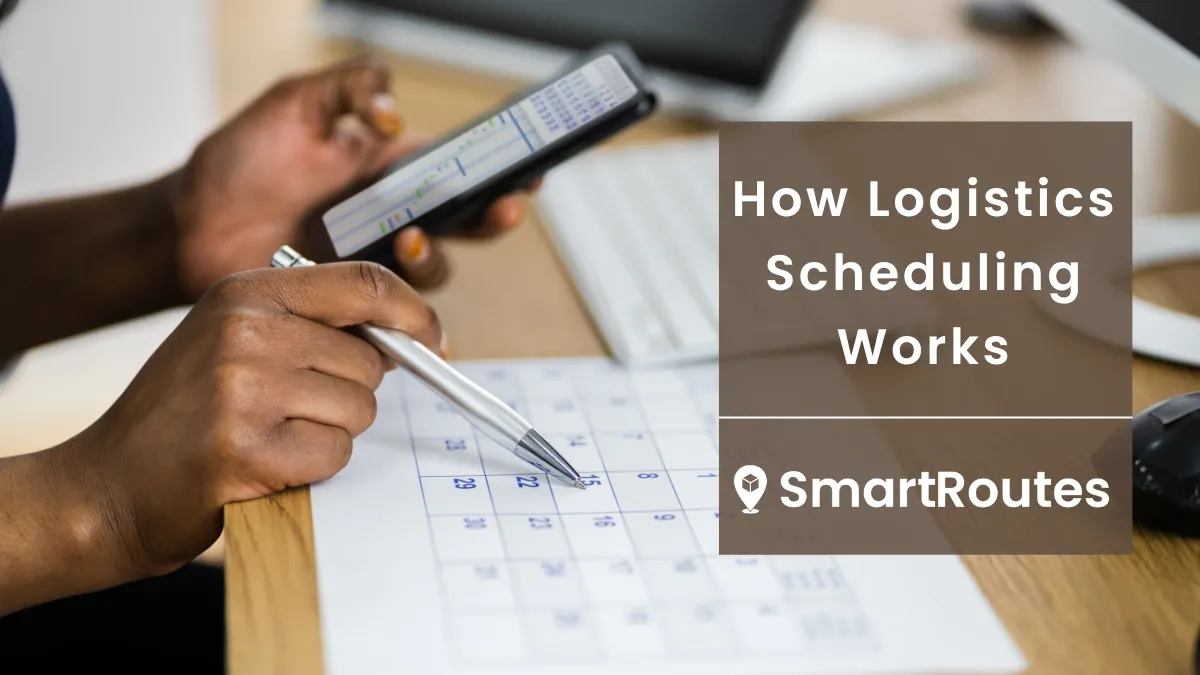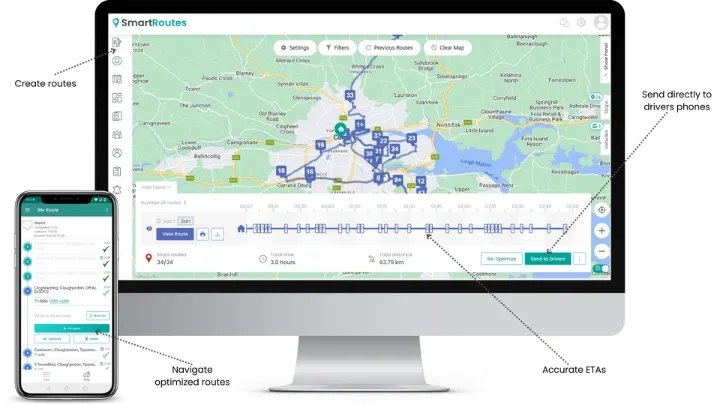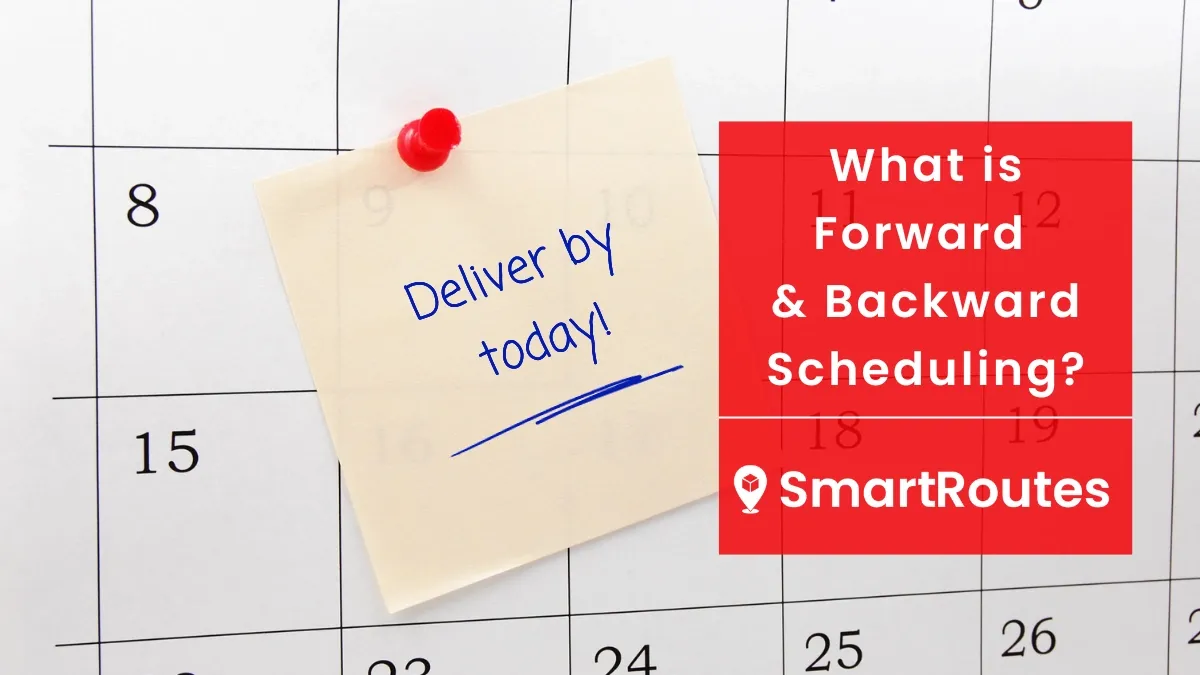How Logistics Scheduling Works & Making it Efficient
In this comprehensive guide, we delve into the core principles of logistics scheduling and how to improve scheduling efficiency.

For any business in transport or logistics, the proof of how well they are performing is in how quickly they are delivering goods without any mishaps. Like a good referee in a football game, the best logistics operations often go unnoticed by customers when they are great, instantly noticed when they are anything less.
For successful businesses that incorporate any type of delivery, getting a logistics scheduling process in place is key. The smooth operations of the businesses, the satisfaction of your customers, and the sanity of your employees are all reliant on the process working perfectly.

How it works in practice isn’t as easy as it might seem. If it was, there wouldn't be full degrees dedicated to it at top universities around the world. At its core, however, is the basic principle of getting the right goods to the right place at the right time, as efficiently and cost-effectively as possible. Of course, to do this, you need to be methodical and pay close attention to detail in the planning process.
While a degree in logistics will be a big help, understanding the fundamentals is likely to put you on a good footing if you're planning to implement a new logistics plan, or you're revising your current under-performing one.
This blog will take a look at some of these logistics fundamentals and we’ll also provide some useful tips to get started with your own logistics scheduling plan.
What is Logistics Scheduling, and Why Does it Matter?
Logistics scheduling refers to the planned and coordinated timing of the delivery of goods. It can involve making accommodations for a variety of factors such as vehicle and driver availability, delivery SLAs, and customer demands and needs. Logistics teams may schedule by the week, day, or hour depending on the scale of operations (e.g. global shipping vs last-mile delivery).
In effect, the overall aim of logistics scheduling is to get the right goods, to the right place, at the right time, as efficiently and cost-effectively as possible. The majority of logistics businesses use forward scheduling to ensure that goods arrive as early as possible.
SmartRoutes logistics scheduling software
Streamline your entire delivery process, all from one platform

At the core of how every business that deals in goods operates, is a supply chain that needs to enable the fast and effective movement of goods. For example, if a shipment of Christmas decorations doesn’t arrive from an origin country before December, it will make it much more likely to impact the company that made the order financially due to having less time to sell them. While this example is at the end given the seasonality and short window of opportunity to swell the goods, there is a certain level of urgency associated with every shipment or delivery. Especially when dealing with FMCG, there are often sell-by-dates that make it even more important.
Logistics scheduling is therefore critically important not just to delivery businesses and their customers, but to the wider economy as a whole. Granted, the concerns of our readers will likely be with the former, but it does indicate why scheduling is such an important activity in the wider supply chain and logistics industry.
How to Schedule Logistics Efficiently
Scheduling the delivery of goods is easy.
It’s doing it in a manner that is efficient and free of mishaps that's the hard part.
What seems like a daunting task, can be much more achievable than you think. The trick is to follow a process and focus on the quicksand easy wins to get you started. Scheduling logistics more efficiently is a game of incremental improvements that ultimately show real results in your delivery metrics.
Below, we’ve detailed 5 of the top tips we have for improving your logistics planning and scheduling process:
1. Examine what is currently working and not working in your scheduling process
If you’re already delivering goods, the chances are you’ve got at least some kind of process in place for scheduling deliveries. Even if you have been doing it using a solution like Microsoft Excel or even pen and paper, what you have built up in terms of knowledge and data makes it the right place to start. Even if you’ve been using other solutions like warehouse scheduling software, the data within these solutions will; help you to identify where inefficiencies exist in your current process.
How might it look?
If you analyze small things like missed deliveries, customer complaints, or even the volume of email communication between individual clients, you can quickly identify areas of improvement.
While this might seem obvious, many logistics managers will jump to logistics scheduling software as the answer to their problems, when in reality, fixing the small things will have the biggest impact on results.
2. Leverage the experience of everyone in the process
Our second tip echoes much of what we preach in our first: utilizing the information that you have to hand first before investing in solutions or consultants.
Many supply chain and logistics professionals often forget that those who know their businesses the best are the people who work for them day to day. We’ve all started new jobs, and over time, naturally found ways to do our work more efficiently. However, we often take it for granted as part of the ‘learning process’ and never share the information with colleagues.
Supply chain planning and scheduling is one of the most formulaic and methodical processes across any industry. The US military has used Lean Management Principles to improve operational efficiency, reduce waste, and optimize resource utilization. These principles have subsequently been adopted by businesses to improve their supply chain and logistics management, including reducing lead times, inventory levels, and transportation costs right across the world.
Be it a dedicated logistics scheduler, drivers, warehouse workers, or back-office staff, everyone in your business will have a unique perspective on part of your logistics workflows that can help to improve scheduling.
3. Use a route scheduling software that meets your needs
While many solutions exist to solve problems at various stages in the supply chain, route scheduling software is something that no delivery business should be without in this day and age.
Route scheduling solutions take the guesswork out of planning, and use machine learning to improve on schedules on an ongoing basis. In simple terms, that means that every time a driver serves a route, the system analyzes their behavior to improve upon it the next time.
As well as making the routes themselves more efficient, it can save logistics teams hours wasted planning routes for logistics manually.

4. Use real-time transportation analytics
Using the right technologies can be the difference between making scheduling more difficult, or making it easier. Despite the promises of many software solutions, they can convolute your current processes and not be as user-friendly for staff as promised.
However, for scheduling routes, it is recommended that you utilize a real-time traffic analytics solution to avoid time being wasted by drivers sitting in traffic, and missing delivery ETA’s as a result.
Even simple and free solutions like Waze are great for identifying areas where there is likely to be traffic congestion, road closures, or any other delays.
5. Continuous review and improved scheduling
Route scheduling isn't something you can implement once and expect to work perfectly. It’s an iterative process of identifying small inefficiencies and resolving them on an ongoing basis.
This is where a lot of logistics scheduling workflows break down because they do not get the regular fine-tuning that they need.
It’s important to establish a cycle of regular reviews of the scheduling process, taking into account feedback, data analysis, and technological advancements that can make an even greater impact on your operations.
This is what sets large, successful delivery giants like Amazon and UPS apart. They are process-driven businesses that are constantly analyzing their data and making improvements.
It’s good practice to schedule a quarterly review of your scheduling process and see if improvements or alterations can be made.
Getting on the right road with Logistics Scheduling
In the world of logistics and supply chain management, finding the right tools and solutions can be a game-changer for your business. SmartRoutes are an industry leader in everything logistics, with a particular focus on route optimization, planning, and scheduling.
Built by a team of supply chain and logistics experts, it helps businesses to transform how their delivery operations work. You can get started with a free 7-day trial.
Frequently asked questions
1. What is logistics scheduling?
Logistics scheduling is the systematic planning and coordination of the timing of goods deliveries within a supply chain. It involves optimizing routes, allocating resources like vehicles and drivers, and ensuring that goods are delivered to their destinations on time and cost-effectively. Logistics scheduling plays a crucial role in ensuring efficient and reliable transportation of goods.
2. What are the benefits of continuous scheduling improvement?
Continuous scheduling improvement offers several advantages, including increased efficiency, reduced operational costs, and improved customer satisfaction. By regularly reviewing and fine-tuning scheduling processes, businesses can identify and eliminate inefficiencies, optimize resource allocation, and adapt to changing conditions. This leads to smoother operations and better overall performance.
3. How can real-time transportation analytics improve logistics scheduling?
Real-time transportation analytics can enhance logistics scheduling by providing up-to-the-minute information. With this data, logistics managers can adjust routes, reroute vehicles to avoid congestion, and provide accurate estimated arrival times to customers. It minimizes delivery delays, reduces fuel consumption, and enhances overall efficiency.
4. What are the common challenges in logistics scheduling and how can they be overcome?
Common challenges in logistics scheduling include route optimization, resource allocation, driver availability, and unexpected disruptions. These challenges can be overcome through the use of advanced scheduling software, which automates route planning and considers various factors. Additionally, continuous monitoring and feedback systems can help identify and address issues promptly, while flexible scheduling allows for adjustments in real-time to accommodate changes and unexpected events in the supply chain.
If you enjoyed this blog, you might also be interested in:








